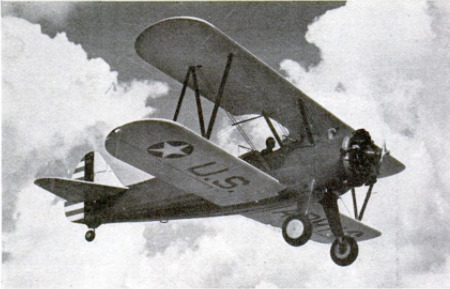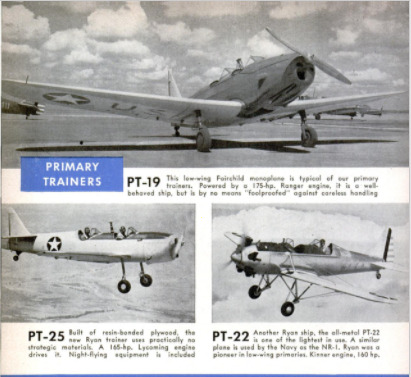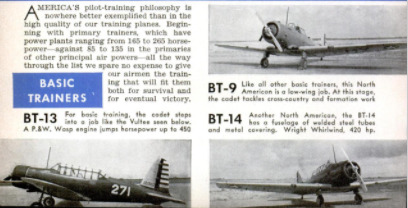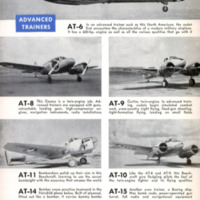-
Title (Dublin Core)
-
U. S. best flyers' training
-
Article Title and/or Image Caption (Dublin Core)
-
Selection, training, integration - three reason why we have the world's best flyers
-
extracted text (Extract Text)
-
"OUR FLYERS are the best in the
world!"
So says General H. H. Arnold, com-
mander of the U. §. Army Air Forces, Flat
statements from Arnold are rare. He is as
cautious in speech as he is daring in tactics.
He made the statement to a graduating
class at Randolph Field a year and six days
after Pearl Harbor. The commander had
adequate time to draw a real conclusion.
Then he quoted the score to prove it.
From February 1 to December 5, 1042, the
Army Air Forces had destroyed 928 enemy
aircraft, losing but 234 of their own; an
all-over advantage of nearly four to one.
Consider the fact that most of our air-
men lacked previous combat experience,
and faced air organizations seasoned by
three to five years of actual warfare.
What is it then, that our flyers have
that qualifies them to remain alive in the
face of this superior experience, and to
roll up overwhelming evidence of personal
superiority ?
Some theorists claim that the average
American is physically and psychologically
superior to the typical Axis warrior. Our
practical militarists prefer to let Herr
Goebbels carry the propaganda ball for
the super race, while we build a super air |
force from plain average-run Yanks.
Leaving the Superman theory to Axis
prevaricators and comic-book artists, it is
possible to trace the military margin to
more prosaic reasons; selection, training, |
and integration.
Our pilots have more flying time before
they get a look at the enemy than most |
Axis airmen have before they are finally
shoveled under. The typical Yankee combat
pilot has 200 flying hours in primary, basic, |
and advanced training; 100 more in transi-
tional schools; 200 in operational schools; |
and a final polishing off right behind the
theater of combat to fit him into the local |
military conditions. In the 1918 scrap, pilots |
were sent into battle with about 90 hours,
to face veterans of three years’ combat. |
The Germans knocked them down with both
hands. This trip it is different.
Typical of the reports on the results of
our training is one that came back with
the 19th Bombardment Group, home from
Australia. For several anxious months, 48
Flying Fortresses had held the balance be-
tween success and failure in Japan's at-
tempt to invade the down-under continent.
Now that proper reinforcements have been
sent there, and the war-tired veterans
brought home to spread their experience
among the younger airmen, it is safe to
tell how thin that red line was between
ourselves and defeat. While it would be
unjust to state that these 48 crews, unaided,
held off attack, their constant pounding of
Rabaul and other points probably set the
Japs off balance so that a full-scale jump
onto the continent was impossible.
The total score of these craft that oper-
ated unaided by fighters may be remem-
bered as long as airmen fight in the sky.
Most Americans reading in dispatches from
Australia before last November that Gen-
eral MacArthur's Fortresses had again
raided Jap installations in New Guinea, pic-
tured swarms of four-engined Boeing B-17's
leaping out of carefully constructed, mirac-
ulously camouflaged runways, to pound
Rabaul again and again.
It wasn't that way. MacAr-
thur's Fortresses were for many
‘months a mere four dozen, many
of them patched from wrecks
dragged out of the Philippines.
They were kept in the air with
Yankee ingenuity, defended on
the ground with plain guts, and
kept potentially dangerous by the
best training and teamwork ever
known to mankind. They were
attacked with the best fighter
equipment the Mikado could con-
Jure up. Still the Fortresses re-
mained as the outer rampart of
the continent. Now, amply re-
inforced, Australia appears im-
pregnable.
The evidence piles up that Gen-
eral Arnold is right. As the final
scores are tabulated the total in-
dicates that the four-to-one ad-
vantage is holding and growing
greater. The margin of superi-
ority holds and holds well. Why?
We, as a nation, are willing to
spend the money for adequate
training. While time is carefully
doled out and every tick of the
cadet’s clock put to work, we
have skimped no material and
effort to give our airmen the best
possible chance of survival and
victory. Our selection for air
training is made strictly on merit
and performance. Compare this with the
German system where the first requisite
for nomination to the Luftwaffe is race and
political connection. In Nippon, selection
is made by family.
Like the aircraft they fly, our airmen’s
superiority comes first from the selection
of proper materials. Making silk purses
from sow’s ears and pilots from ninnies or
ham-fisted thickskulls is equally disappoint-
ing work. The Air Force's first job is to
get men who are first-rate timber.
The cadet selection board takes the first
step in the necessary weeding out. The
basic primary physical requirements are
well known. A good airman must have the
stamina to stand up to the physical wallop
that aviation gives the human frame. The
innovation is in the psychological factors
involved: is the man men-
tally equipped to fly? If so, what kind of
flying will he be good at? Does he belong
in the cockpit at all, or at the navigator’
table or lying flat on his stomach operating
our precious bombsight ?
The young American, below the age of
27, in good health and possessing at least a
high-school education or better, applies to
his local cadet selection board with three
letters of recommendation from persons of
standing in his community. He undergoes a
physical examination similar to that given
any officer candidate. Subsequent tests tell
more about his personal qualities and quali-
fications than any number of diplomas or
letters of recommendation, however detailed.
They show exactly where he stands in the
things that the Army needs in its flyers.
The most important fact which the primary
psychological search tries to determine is
whether the cadet candidate is mentally
equipped to learn—whether he can absorb
the complex information about to be flung
at him completely, accurately, and in the
short time which the war emergency pro-
vides for him.
This qualifying exam has proved so ac-
curate that the two-year college require-
ment, previously held as absolutely neces-
sary, has now been virtually abandoned.
Actual military experience indicates that,
in many cases, a purely academic attitude
may Kill the very instinct that makes an
audacious pilot, an imperturbable bom.
bardier, or a nerveless navigator.
The primary examination has been rigged
Dy the psychologists to determine whether
the candidate has the basic stuff of which
Afr Force personnel is to be formed. Can
he comprehend instructions? Can he size
up new and unfamiliar materials and situ-
ations? Can he follow directions accurately
without lengthy auxiliary explanations? His
judgment must be dependable, his sense
of organization flawless. The qualifying
exam weeds out most of the unfits, but
the dangerous job of weeding out the bor-
der-line cases comes farther along the line.
Once appointed, the men are moved along
to the reception centers, where they are
sorted out to determine just what job they
will hold later on. Commissioned air-crew
members are divided into three classes of
activity; bombardiers, pilots, and naviga-
tors. There was a time when men who
were unable to make the grade as pilots
were trained to hold the other two posts.
Psychologically, this was a poor system, a
relic of World War I. In spite of itself, it
produced some excellent air-crew members,
simply because the basic requirements for
navigator and bombardier differed so vastly
from that of the pilot that there was a good
chance that if the man flunked out in his
flight checks, be had what it took for one
of the other two air posts.
‘The bombardier requires excellent hand-
eye co-ordination, superior finger dexterity,
great motor steadiness, and the ability to
‘make complex calculations under conditions
of the utmost stress. In addition to this,
Be must have sufficient mechanical aptitude
to operate the complicated bombsight.
A pilot, on the other hand, must be able
to absorb the complex motor skills involved
in fying, the physical business of getting
one’s hands and feet together and in perfect
rhythmic movement, to go through the
complex motions required in flying the
modern airplane. He must demonstrate
superior reaction time and an ability to
make quick, accurate observations, and
possess a certain cockyness required for
combat. The fighter pilot should, in addi-
tion, possess a certain “killer instinct” that
makes him different from other pilots or
alr-crew members.
The navigator, on the other hand, must
De the imperturbable pedant of the crew.
Besides the prerequisite flair for mathe.
‘matics, he must possess not only the motor
co-ordination required for the handling of
‘navigation instruments, but also a calmness
that permits him to continue his calcula~
tions despite setbacks and interruptions.
A battery of tests awaits the cadet when
he arrives at one of the reception centers.
His case history, his childhood, and his edu-
cation are carefully checked into. Another
written examination follows, but the bur-
den of the physio-psychological determina.
tion of what he is good for is bone by
apparatus tests which determine which
of the three jobs, if any, he is good for.
The apparatus is purposely deceiving, so
that no ambitious kid fitted for the navi
gator’s post may deliberately flunk his way
into flying school.
There are no hard-and-fast rules about
selection. The psychologists are working on
new examinations all the time, and when
new tests are rigged and found to be more
accurate, they are placed in the examina-
tions, supplementing or replacing those
in use. For instance, there is the simple
peg-turning test. Students are placed at a
board in which are set rows of pegs. Half
the peg tops are painted black, the other
half white. The student is instructed to
turn each ome 180 degrees. The time and
accuracy are clocked and recorded. A simi-
lar test of moving pegs from one board to
another a full arm's length away, checks
arm and hand dexterity.
Discrimination reaction time is tested by
red and green lights placed on a board in
front of a seated student. Certain combina-
tions are extinguished by switches at the
student’s hand. When
the cadet gets the
right switch to match
the combination, a
white signal light
goes out. The factor
recorded is the
amount of time it
takes the cadet to
extinguish the white
light in 50 tries.
Serial reaction
time is another char-
acteristic which the
psychological lab
tests with great in-
terest. Its rig seats
the cadet at a set of
dummy airplane con-
trols, stick and rud-
der, in front of a
board on which a set
of light buttons de-
scribe the three-di-
mensional motions
of a plane in flight.
The lights are set in
two rows, one red
and one green. The
lines of lights de-
scribe a curve across
the top for bank or side-to-side motion of
the stick, up and down for the stick’s for-
ward and back movement which represents
nose up or down in the plane. A straight
horizontal set records the movements with
the rudder bar. With a complicated set of
electrical switches, the examiner flashes a
control position, indicating it with one set
of lights. The student must then bring
the controls into such a position as to light
the set of buttons opposite those already
lit. The reaction time and accuracy is
tested.
Most cadets think this test is exclusively
for testing prospective pilot ability. Actu-
ally no one test determines a final selec-
tion. This piece of apparatus merely indi-
cates how well a cadet can get his hands
and feet to act in unison to produce a de-
sired effect under pressure. Many a bud-
ding pilot has been “thrown” by this hurdle,
fearing lest this was the final test whether
he was to fly, navigate, or bomb.
Steady hands are a prerequisite in all
three posts in a bomber. The pilot must
be able to fly a straight course to an objec-
tive through a hail of antiaircraft fire in
the final bomb run. The bombardier must
lie and manipulate his sight while the rest
of the crew mans machine guns to ward
off the attack; the navigator must hold the
sextant in untrembling hands when all his
precalculated courses are shot to the devil
by adverse weather
or military condi-
tions.
The cadet is seated
at a tiny box in
whose cover is a nail
hole. He is handed a
charged metal sty-
lus and told to insert
it in the hole and
hold it steady, with-
out touching the
sides. If a contact is
made, the circuit is
closed and a point
is recorded against
the student. Fore-
warning the student
as to what is going
to happen has little
or no effect on the
result. He sits down,
determined to hold
steady, come what
may. Then a non-
commissioned officer
sneaks up behind
him murmuring such
words of encourage-
ment as, “So you
think you'll be able
to fly, flutterfingers—why, you cluck, there
are better heads than yours on cabbages.
If you can’t hold still now, what'll you do
when the ack-ack starts shooting?” Then a.
bunch of scrap-metal hung from the ceil-
ing in the opposite room is dropped with a
sound like the crack of doom, or a klaxon
is sounded close to the cadets ear. No
one is perfect on this test, but a low-failure
score on this test is a good indication.
Bimanual co-ordination, the art of get-
ting each hand to work at a separate job
to achieve a single unified result, is gauged
by another test. If you don’t think this
requires skill, try this simple test on your-
self: place your left hand on top of your
head, your right on your stomach. Rub
your head with a circular motion, your
Stomach crosswise. Then try speeding up
the circular motion on the head and revers-
ing direction without breaking either the
rhythm or direction of the right hand. This
kind of co-ordination is essential in many
of the air-crew jobs. The newest piece of
equipment to test this is the lathe-type
tester. It consists of a flat, rotating disk
like a phonograph turntable, over which
rides a sliding arm with a dual-direction
stylus. The movements of this stylus are
controlled by two wheels, similar to those
on a lathe. There is a spot on the disk,
whose motion, direction, and rate of travel
are highly erratic. The cadet is supposed
to keep the stylus in contact with the spot
by means of two wheels. The examiners
record the number of times the cadet loses
contact with the spot.
New tests are introduced continually,
not only because the psychological division
is extremely progressive, but also because
frequent discussion of the tests between
students may rob them of their effective-
ness. - Certain tests must be a surprise to
be effective; others remain standard for a
long time.
At the reception centers, the students are
given a chance to register their prefer-
ences in assignments. In the beginning,
there was a mass rush toward the pilot
appointment, but a well-organized cadet-
relations program has convinced many stu-
dents that the man who flies the plane is
just the aerial hack driver, and increasing
numbers bid for navigator or bombardier as
first choice.
Wherever possible, the student is given
his choice of assignments. In horder-line
cases, his preference is the deciding factor.
Nevertheless, if he shows marked tenden-
cies toward navigation, has the necessary
education, and has the systematic mathe-
matical mind required for such a job, he is
counseled to accept this appointment.
Once the selection is made, the cadets are
sent to Army preflight schools for nine
weeks of Army education. Pilot candidates
then move off to established Army primary
flying schools to absorb the rudiments of
flying.
Here the cadet makes the acquaintance
of the PT series, a rugged group of pri-
mary trainers designed to give the pilot his
aeronautical ABC's. He learns to taxi, take
off, fly straight, climb, turn, glide, and
land. He learns to land with and without
power, upwind and crosswind. He learns
to spiral and side slip; to stall the plane,
power-off and power-on; to spin and re-
cover. During this procedure, acrobatics
are stressed, along with steep turns and
chandelles.
The thing that makes our elementary
flight training unique is the type of equip-
ment we use, from the very beginning. The
line of U. 8. primary trainers includes the
Stearman, Fairchild, Ryan, and others. The
lowest powered of these ships carries 165
hp. The average is 210; some even run 265.
Italy's average primary trainer is powered
by ‘a 100-hp. engine, Germany's average
runs 90, and Britain's is in the 135 bracket,
while Japan's primary trainers are reported
to carry somewhere in the neighborhood of
85.
American instruction is based on co-
ordination and judgment. It is built on the
idea that the military pilot is destined to
fly airplanes with power enough to get him
into trouble if he fails to respect it—and to
get him out if he handles it right.
The popular Fairchild PT-19, a low-wing
monoplane powered by a 175-hp., six-in-line
Ranger engine, is typical of the Army's
trainers. A well-behaved airplane, it Te-
sponds obediently to controls, exhibits no
control trickiness or flying vices of any
kind. On the other hand, no advanced aero-
dynamics have been built into the airplane
to compensate for students’ sloppiness in
flight technique. The Fairchild is built with
a sturdy, welded, steel-tube fuselage. Its
wings are of resin-bonded spruce, fabric-
covered. Unlike most primary trainers, the
PT-19 is equipped with a flap or air brake;
not that its landing speed requires it, but
because some instructors think that its use
should be made part of the flying routine
early in the cadet's career.
The newest of the trainer series, the Ryan
PT-25, a ship built entirely of resin-bonded
Plywood, also has a flap. Many of the pri-
maries, however, still retain the old-fash-
ioned biplane rig. Orthodox builders find it
easier to incorporate the basic requirements
for this ship—stamina—into the two-wing
design. These types include the PT-15, the
St. Louis trainer, powered by a 225-hp.
Wright Whirlwind; Stearman‘s PT-13, pow-
ered by a 225 Lycoming radial; 17 and 18,
which are identical except for thelr power
plants—the 220-hp. Continental and the
225 Jacobs. The Waco PT-14, powered usu-
ally with a 220 Continental is also in wide
use. The lightest in the series are the
Myers, a small biplane powered by a 145
Warner engine, and the Ryan PT-22, pow-
ered by a 160-bp. Kinner engine. Both of
these ships are of all-metal construction.
The next jump is into basic training air-
planes. All of these are low-wing mono-
planes. The power is suddenly doubled.
Sensitive flaps, landing flaps, and a con-
trollable-piteh propeller add considerably to
the pilot's woes. Most of these ships are all
metal, weigh over two tons fully loaded,
‘and are equipped with a panel full of instru:
ments and two-way radio. Here the cadet
learns instrument flying, cross-country fly-
ing, and primary formation fying. Here he
puts into practice the ground-school educa-
tion—navigation, meteorology, code and
volce communications that have been
pounded into his cranium between fights.
The most commonly used equipment in
this class is the North American BT-l4,
powered by a 420-hp. Wright Whirlwind
engine. This ship has a remarkably tough
structure. Like the average primary, its
fuselage is built of welded steel tubes, but
the outer surfaces are fabric-covered alumi-
num sections
bolted to the fuselage. The ship cruises at
about 150 m.p.h. and has a range of 600
miles. In the same general class are the
Vultee, the BT-13 and 15, similar designs
powered respectively with 450-hp. Pratt &
Whitney Wasp and 420 Wright Whirlwind
engines.
Tn the advanced trainer, flying takes on
a serious military aspect. This ship has
most of the characteristics of a full-grown
military airplane—guns, retractable land-
ing gear, high-compression engines, full
navigational instruments, complete radio.
Here the cadet begins simulated combat
training during the day and cross-country
at night. He flies tight formation, lands in
small, unfamiliar fields, shoots the trainer's
fixed guns, gets the theory of combat, and
is further indoctrinated in the science of
air warfare. The North American AT-6 has
been currently standardized for this job,
and turned out in large volume production.
This ship is reputed to be the toughest air-
plane ever built, structurally and opera-
tionally. Its wing is all aluminum alloy,
with two spars in its center section and one
in the outboard panels. Still being a trainer,
it bears the last semblance of the steel.
tube structure in a part of the fuselage up
to the back cockpit. No great effort has
been made to make this ship easy to fly.
While it is no man-killer, it contains all the
potential headaches of fighting ships but in
a lesser degree. The AT-6 has a 600-hp.
engine and all the grief that comes with it.
The cadet learns to baby his engine after
take-off, the art of getting the maximum
performance out of his power plant on long
cross-country flights. He has learned ad-
vance aerobatics, elementary gunnery. In
the primary and basic types, the cadet has
learned to be a pilot; in the AT series he
learns to be a sky soldier.
By the time the student completes Ad-
vanced Training, his instructors know what
kind of pilot he is going to be. The pursuit-
talented kids go off to their particular type
of advanced and operational training, the
bombers go to be molded into an integrated
crew.
Basic combat trainers are merely AT's
armed with four .30 caliber fixed machine
guns and a couple of camera guns. The
pursuit pilot's life from this point on is
filled with aerobatics and gunnery. He
graduates to obsolescent P-40's and is final-
ly polished off in the latest equipment,
taught operations, and sent to a combat unit
which finally teaches him local conditions
whose acquaintance is the price of survival.
The bombardment-pilot cadet has, in the
meantime, joined up with units handling
twin-engined trainers which first give him
the rudiments of multi-engined ships. The
Curtiss AT-9 and the Cessna AT-17 teach
him the fine art of engine synchronization,
how to fly with one engine dead, and the
complicated procedures of handling engines,
props, flaps, and the 13 other major con-
siderations in taking off and landing larger
ships. Furthermore, he learns the art of
dividing the job with a copilot. In the
meantime, other members of the air crew
have been selected and trained. The officer
members he left behind in the classification
centers as bombardier and navigator join
up at this point.
The secrecy that shrouds the bombsight
prevents discussion of the bombardier’s
training, but it should suffice to say that
these lads can hit a pickle barrel from
10,000 feet. They have gotten most of their
practice in the Beechcraft AT-11s, a twin-
engined job powered by 450-hp. Pratt &
Whitney Wasps. The navigator's time has
been spent chiefly in the AT-7, similar to
the 11, lacking only the bombardier’s nose.
The next step is into crew trainers. Here
the other members of the bomber’s crew—
radio operator, flight engineer, and ar-
morer—are added. These men are non-
commissioned officers, graduated from the
special schools of the Air Forces Tech-
nical Training Command. Specialists in
their individual fields, they were found
physically and temperamentally fit to be
air-crew members, and, after completing
their specialized ground training, were sent
to gunnery schools to learn the art of
handling the free and turret-mounted .50
caliber machine guns that arm our bombers.
The bombardier and navigator also got
flexible gunnery practice, 50 that they can
man their posts when the bomber goes into
combat.
From the crew trainers, the men enter
the ships in which they will finally face the
enemy. Veterans, back from combat units
(we have some after a year of war), give
the new crews the latest dope on combat
and survival. Then they are shipped off to
the theaters of war. They are not, how-
ever, flung into battle immediately. The
process of indoctrination continues. Opera-
tional training under escort, in formation
with veterans of the area, gives the new
men the feel of being artists in destruction.
-
Contributor (Dublin Core)
-
William S. Friedman (Article Writer)
-
Language (Dublin Core)
-
eng
-
Date Issued (Dublin Core)
-
1943-04
-
pages (Bibliographic Ontology)
-
96-102, 210, 212
-
Rights (Dublin Core)
-
Public Domain (Google Digitized)
-
Archived by (Dublin Core)
-
Matteo Ridolfi
-
Marco Bortolami (editor)
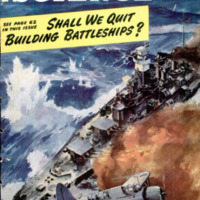 Popular Science Monthly, v. 142, n.4, 1943
Popular Science Monthly, v. 142, n.4, 1943

